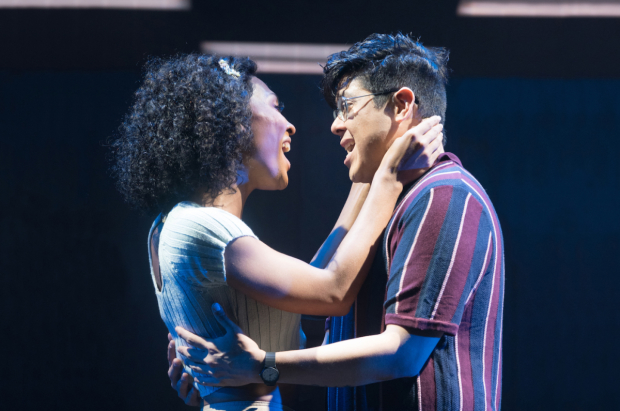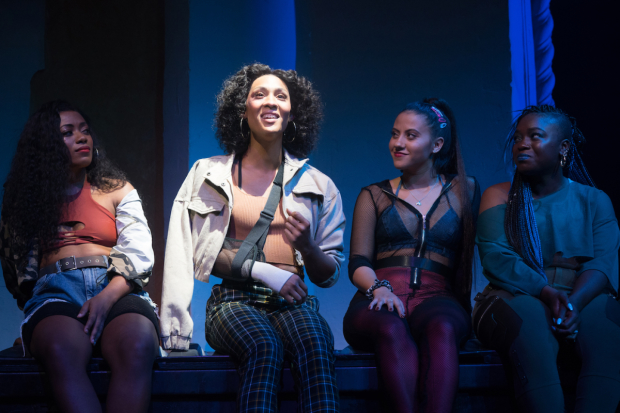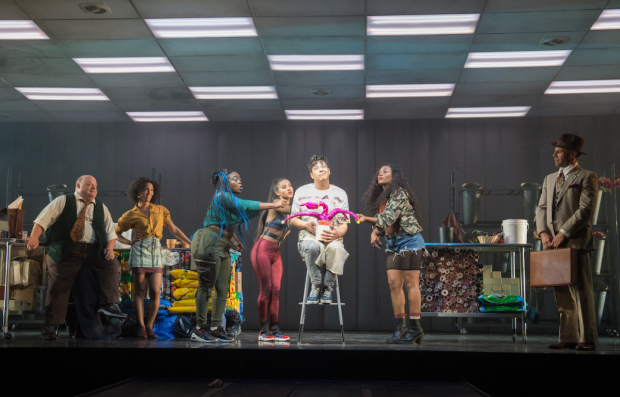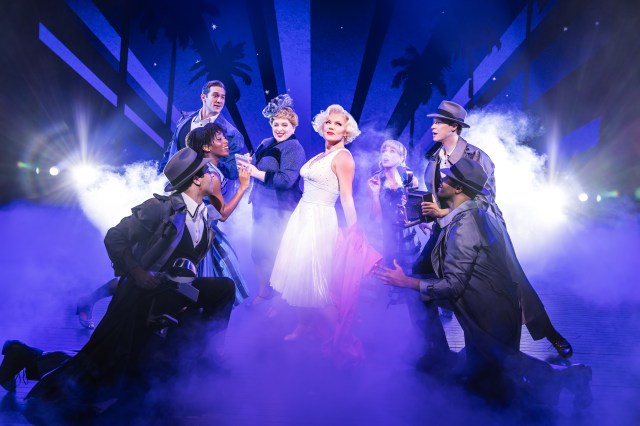George Salazar and Mj Rodriguez Lead an Avant-Garde Little Shop of Horrors
Mike Donahue directs this reimagined ”Little Shop” at Pasadena Playhouse.

(© Jenny Graham)
Pasadena Playhouse has produced a reimagined Little Shop of Horrors, the hit musical about a man-eating plant and the schlub who feeds him human flesh. Alan Menken's memorable music and Howard Ashman's lyrics, with their loving detail for puns and storytelling, still makes this musical special. This revival, however, may leave audiences hungering for more than it can offer.
In an American city circa the 1960s, self-professed loser Seymour Krelborn (George Salazar) finds a strange plant after a total eclipse, and the Skid Row flower shop where he works becomes a phenomenon after people gather to look at this mysterious specimen. Because of his undying love for the beautiful but fragile Audrey (Mj Rodriguez), he names the plant Audrey II. But Audrey II needs more than water and sunshine — it wants blood. And if Seymour expects to get the girl and the fame, he had better provide.
Based on the 1960 Roger Corman horror-comedy, Little Shop of Horrors combines dark Faustian themes with the fairy tale world of '50s and '60s sitcoms like The Donna Reed Show. Hilarious songs like "Feed Me" service the former while "Somewhere That's Green" recall the latter. That clash of violence and innocence provides the show with some of its best laughs.
George Salazar, fresh from Broadway's Be More Chill, perfectly embodies Seymour. A passionate singer with an endearing awkwardness, he's lovable from the get-go — a character twist for a hero who eventually slaughters people and feeds them to a carnivorous plant.

(© Jenny Graham)
But a big obstacle with a show like Little Shop nowadays is that there's little to laugh about when it comes to physical and sexual abuse. Audrey has been manhandled by her sadistic boyfriend, the dentist Orin (Matthew Wilkas). Rodriguez (a trans performer who stars on TV's Pose) plays Audrey not as a dumb blond, but as a steel magnolia, always being broken into a million pieces, but capable of putting each piece back together and persevering. Rodriguez's singing voice works well with "Somewhere That's Green," but she doesn't have the vocal strength to make "Suddenly Seymour" the showstopper it should be.
Kevin Chamberlin is funny but too understated as Mr. Mushnik, Seymour and Audrey's boss. Some of his jokes are swallowed up faster than Audrey II's victims. Wilkas is maniacally hilarious as the villainous dentist who salivates over hurting people both in and out of the dental chair. He also plays several cartoonish characters in Act 2 that are distinct and very funny.
Of the three Urchins, Cheyenne Isabel Wells is the strongest dancer. Both Tickwanya Jones and Brittany Campbell have good belts, but they lack Wells's stage presence and rhythm. Amber Riley from TV's Glee, lends her soulful presence to Audrey II, managing to be both bluesy and threatening.
The production's problems lie with direction, choreography, and musical direction. The piece is a wild, crazy horror mash-up, but Mike Donahue's direction is slow-paced. This should be a frantic show, but much of the zany energy is missing. Will B. Bell's choreography has a few clever twists, but because Jones and Campbell are not strong dancers, it seems he doesn't give the threesome enough impressive movements to do. Add to that, the band lacks the vitality that the songs usually require.
The puppetry, created by Sean Cawelti, attempts something avant-garde. Audrey II is more abstract than the usual massive beast in other productions, and for the most part, where phantom branches taunt the characters, the approach is effective. Near the end, though, when Audrey II goes on a spree, director Donahue attempts to hide the puppet's lack of heft by flashing strobe lights in the audience's eyes. It feels like a cheap trick, a distraction that doesn't achieve its goal of dazzling them with a worthy climax.
Set designer Dane Laffrey's conversion of an empty stage to a sterile flower shop, lit by dull fluorescent lights and bordered by dirty plastic strips, creates a creepiness perfect for the setting of multiple murders. Orin's dental chair, where many of his crimes occur, rises from the floor in a heap of smoke like it's greased lightning, creating a crafty visual joke.
With this casting, Little Shop of Horrors draws attention to the real-life hell of class disparity and sexual abuse. But a show about a man-eating plant with a doo-wop girl group Greek chorus should be more fun than this production.

(© Jenny Graham)








